The opening pages of "The Little Book of Joy" show two boys with two very different childhoods: "One of us grew up in a little house. One of us grew up in a big house."
Desmond Tutu was raised in a farming and mining town in South Africa. And while the 14th Dalai Lama was also born in a small house in a remote Tibetan village, he was identified as the Dalai Lama at a very young age and brought to live in a palace.
But despite being far away and very different from each other, in different circumstances, both characters in the book are sad and lonely, and their quest to find and share happiness brings them together.
Archbishop Desmond Tutu and His Holiness the Dalai Lama are arguably two of the most significant spiritual leaders of the last century. Both leaders have faced enormous strife — whether in apartheid in South Africa or in the Tibetan Uprising or the aftermath — and through it all, both have tirelessly worked towards peace.
The two leaders met in 2015, and in a series of conversations, tried to answer a seemingly insurmountable question: "How do we find joy in the face of life's inevitable suffering?" These conversations became a guidebook for adults in 2016, and now they're adapted for a children's book.
San Diego artist and muralist Rafael López's illustrations are as beautiful, captivating and empowering as the book's message. López uses swirling stripes of colors to represent the way joy emanates from and around the characters — and even the animals and natural world. In this way, joy's infiniteness and its ability to be sort of transmitted are granted a visual, tangible reality — something both kids and adults can see and understand.
Joy is around us, and joy doesn't run out, the book reminds us: "We discovered that the more joy we shared, the more joy we had."

Rafael López has illustrated more than a dozen children's books, including the bestseller "The Day You Begin" with Jacqueline Woodson, and "Just Ask! Be Different, Be Brave, Be You" by Sonia Sotomayor. He's also designed many murals around San Diego, where he collaborates with communities and schools to bring people together while they paint. López joined KPBS Midday Edition to discuss the book, joy, and the life and words of Archbishop Tutu and the Dalai Lama.
"The Little Book of Joy" began as a book for adults, published in 2016, and it was based on a visit between the Dalai Lama and Archbishop Desmond Tutu. Can you tell us what happened in that visit?
López: Yes, I believe that the co-writers of the new book — Douglas Abrams is very close to the late Archbishop Desmond Tutu, and Rachel Neumann is very close to His Holiness the Dalai Lama. So at one point, I think Douglas Abrams traveled to South Africa and met with the Archbishop, and he said, 'have you ever considered getting together with the Dalai Lama and have a sit-down conversation, because you two have so much in common.' And (Archbishop Desmond Tutu) jumped at the opportunity. He said, 'of course, I'm there.' Eventually, they worked all the logistics out and they got together, and it was pure magic. I was privy to some of the earlier takes of the video because they sent it to me to get a little bit of a feeling of their relationship — and the bantering between the two of them, the sense of humor that they both have, and the conversation was just so refreshing, to see these two people that are so human, and we perceive them as these amazing figures, champions of humanity, but they're sitting down, and they sound like the person that you want to be really close friends with. So it was magic in the making.
The question at the heart of the Dalai Lama and Archbishop Tutu's conversations was: "How do we find joy in the face of life's inevitable suffering?" How do children experience or internalize this?
López: Well, I think that if you just open your phone or you read the news, we realize that we are surrounded with so many amazing, incredible, and difficult challenges, from war-torn regions to refugee crisis to famine to climate change. It could become pretty overwhelming. And even in today's everyday life, for people that are not facing those horrible challenges, we do find things like lack of understanding, solitude. All of us have faced that. And I believe that the message of Archbishop Tutu and the Dalai Lama is that regardless of what you face, because let's think about it, these two people have faced incredible challenges in their own lives, more than you and I could ever face, I think. So, the fact that they were able to find joy by looking very hard and looking around and seeing joy in the world, in the more insignificant things that surround us, you can find tolerance, you can find forgiveness, you can find reconciliation, like in the case of South Africa. And if they could do it, why not send the same message to kids that face maybe a different level of challenges in their life and remind them that the human character is very resilient and that we can find joy even at the darkest of time — and joy has the power to bring light into the darkest of times.
What can you tell us about the process of bringing the story to a children's book?
López: First thing you need to do is to really familiarize yourselves with your two characters. We're all familiar with both of them. I'm in my sixties. I grew up during the apartheid era, where I read every day about what was going on. Finally, you find out who Archbishop Tutu is and what he's doing after apartheid [is] over. And, of course, the Dalai Lama history. It's something that we've all heard about, but I don't know enough about it. I don't know who they are inside, what are their personalities. And the most important thing in this book was how these two get along with each other and how they can find this friendship, and they find these common things that bring them together. They tie them together, and they find this message they want to bring out. So the first thing I do is I saw a lot of their videos during the interview, and many times I was crying, laughing so hard. The two are so funny and amazing, and that gives you sort of like an idea of how you want to express the characters and interpret it for a younger audience.

Can you tell me about some of the symbols that you used in the art to represent joy?
López: Originally, the idea was to portray happiness as rainbows, which I get it, and I think, yes, rainbows — especially the beautiful, diverse colors that we see after the storm, after everything is over, and then the sun comes out and we see the rainbow. But I wanted — and we all agreed too that we needed to actually not find it so easy, because joy sometimes is not easy to find. So we conceptualize the idea that rather than having from the very beginning this rainbow, which, by the way, if you look at the book, once you see the book, it's not going to look like a rainbow. It's more like ribbons of color, which I was inspired by those beautiful ribbons and flags that you see in Tibet.
But if you start the book, in the beginning, you can't see the joy. You can't see the color. You need to find it. It's there, but it's very hidden. It's either the color of this chimney here, there's a little bug over there with a little football made out of, like, rags of color, but it's very far away. And I wanted to create teachable opportunities for teachers of teachable moments where they can actually open the page and tell the kids, where is the joy? Can you find the joy here? My characters look sad and lonely, but there's joy out there. So we thought it was an incredible opportunity to do that metaphorically. Joy could be hidden, and slowly it starts to evolve as a rainbow of colors until it becomes very evident, and it's right there in your face.
So you have illustrated a lot of children's books, and so many of your books center on encouraging and inspiring young change makers. What was it like starting with material from such highly esteemed leaders and change makers themselves?
López: Well, first of all, it's pretty surreal, right? When you get the call and they said they want you to be the illustrator for these two champions of peace, the world peace and world understanding. I was pretty floored. It took me a couple of days to realize the significance of doing this. I'm incredibly honored. I thought that I needed to do my best work to really represent their message as best I could.
And I've always been attracted to stories of underdogs. I mean, being an immigrant myself, my mother wanted to become an architect when she was in the 1950s in Mexico where no woman would ever dare to become an architect at the time, they were all men. And having a kid with special needs as well, I like stories of people that can survive and become stronger and overcome so many challenges. So those are the stories that I'm attracted to when I illustrate books. And this is definitely on the very top, because if you are aware and familiar with their stories of both of their journeys since childhood — it's just amazing what they have been able to accomplish, not just for them, but for the rest of the world in a very moral way, too.
There are incredible messages of this hopeful message of peace, tolerance, reconciliation, compassion and kindness. So, yeah, everything just fell into the right place, and the challenge was a little scary, but I thought I could do it with a little bit of time and lots of meditation and relaxation.








